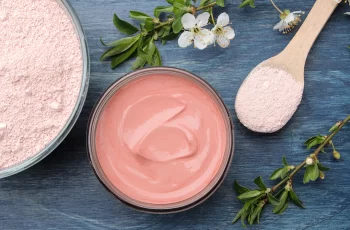
Can You Use Alpha Lipoic Acid with Niacinamide?
When it comes to skincare, we all know that using formulas and ingredients packed with antioxidants is the best way of ensuring our skin remains at its healthiest state. Luckily for us, there are some ingredients that deliver more impressive results compared to others. Alpha lipoic acid, being one of the most used ingredients to help the skin and body reap the rewards. It has been proven that alpha lipoic acid has an antioxidant capacity that is over 40,000% more powerful than a combination of vitamin C and E.
So, is this powerhouse the missing ingredient in your everyday skincare routine, and can you use alpha lipoic acid with niacinamide? Let’s dive in and find out more about how to use these ingredients effectively.
What is niacinamide?
Niacinamide is a form of vitamin B3 and is usually found in skincare formulas, such as serums. Known for its ability to diminish signs of ageing, such as fine lines and wrinkles as well as its beneficial humectant traits. When applied topically, you’ll expect to see significant difference in the overall skin hydration. It can do this with the humectant traits I have already spoken of this is performed by moisture surrounding the face is absorbed into the skin and locked into place. This ensures the skin’s natural protective barrier is strengthened and able to ward off any exposure to free radical damage, caused from UV light, pollution, central heating, harsh climates, and other environmental aggressors.
You will also find niacinamide contains anti-inflammatory properties that help to calm any irritated skin making it an ideal ingredient to include into your routine if you have a dry or sensitive skin type. It isn’t just dry skin types that benefit from niacinamide, oily and blemish-prone skin types will benefit from this clever powerhouse. One other unique trait of niacinamide is its ability to regulate oil production preventing sebum (the natural oil found in the skin) from being overproduced, leading to flare-up in acne and breakouts.
If you wanted to know a little more about niacinamide and how it works on the skin, check out our dedicated blog post.
What is alpha lipoic acid?
Alpha lipoic acid is an enzyme naturally occurring in the body and is formulated into several skincare products. Known for its impressive amounts of antioxidant it has a higher capacity for these free radical fighting compounds compared to vitamin C and E, two separate ingredients that are often found to reign supreme when it comes to antioxidants.
You can benefit from alpha lipoic acid as a supplement, which can come in the form of a capsule, or eating plenty of foods, such as red meat, spinach, broccoli, tomato, and brussels sprouts. By taking it as a supplement you are protecting your body from the inside from all free radical damage. You can also, obviously apply it topically onto the skin, but with this there is a downside to this potent powerhouse, and that is the increased sensitivity to sunlight can cause the skin to burn and experience long-term sun damage. Always ensure you apply a daily SPF to keep the skin fully protected and safe in the sun.
What can you not mix with niacinamide?
Vitamin C is the main ingredient that should not be mixed with niacinamide. Although they both contain impressive amounts of antioxidants, they do not work well together. This is because each ingredient performs similarly on the skin. When mixed will begin to counteract each other rendering each ingredient completely useless.
This doesn’t however mean you shouldn’t use niacinamide and vitamin C in your daily routine. Many find that alternating the time of day the ingredients are applied ensures the skin reaps the rewards, without the worry of suffering from unwanted side effects, such as dryness, itching, or redness. Vitamin C enriched serums tend to give the overall look of the skin a glowing and vibrant finish. Personally, I feel this is the best ingredient to use during your morning routine for all day protection from free radicals, with a healthy, luminous look to the complexion. You can then follow this with niacinamide in your evening skincare routine to help hydrate and repair the skin after a day of exposure to free radical damage from the UV light.
What can you mix with alpha lipoic acid?
There is very little you can mix with alpha lipoic acid, it is in fact, often found in a few product formulations for an added boost in antioxidant protection. However, there is also a limited amount of knowledge surrounding how effective ALA is for the skin. This is something you must bear in mind when you are wanting to introduce it into your routine. For peace of mind, I would suggest consulting with a doctor, dermatologist, or medical professional before applying it to the skin. If you wanted to be extra careful, you could also perform a patch test by taking a 10p size amount of the product and applying it to the inside of the forearm. Leave it for 24 hours and if there are no signs of irritation indicates you skin is happy to have ALA applied to it.
Can you use niacinamide every day?
Yes, you certainly can use niacinamide every day, in fact, you can use it twice a day. Many find that due to its humectant traits, it’s a highly beneficial ingredient to use in the evening before applying more potent skin ingredients, such as retinol. Niacinamide will not only counteract any potential dryness caused by retinol and other acids, such as salicylic acid, you will also find it helps other actives absorb quickly and effectively into the skin.
Can I mix niacinamide with hyaluronic acid?
Absolutely, teaming niacinamide and hyaluronic acid together gives the skin the ultimate boost in hydration. Ideally, I would suggest you apply hyaluronic acid first this will draw moisture and lock it into place. Following this with niacinamide will allow this powerhouse to focus on regulating oil production and minimising the appearance of pores.
There you have a little more information about using alpha lipoic acid with niacinamide. Remember, if you have any questions you can come, and follow us on Instagram.


